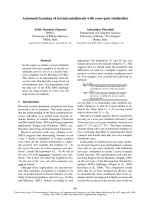Báo cáo khoa học: "Automatic Induction of a CCG Grammar for Turkish" pptx
Bạn đang xem bản rút gọn của tài liệu. Xem và tải ngay bản đầy đủ của tài liệu tại đây (93.19 KB, 6 trang )
Proceedings of the ACL Student Research Workshop, pages 73–78,
Ann Arbor, Michigan, June 2005.
c
2005 Association for Computational Linguistics
Automatic Induction of a CCG Grammar for Turkish
Ruken C¸ akıcı
School of Informatics
Institute for Communicating and Collaborative Systems
University of Edinburgh
2 Buccleuch Place, Edinburgh EH8 9LW
United Kingdom
Abstract
This paper presents the results of auto-
matically inducing a Combinatory Cate-
gorial Grammar (CCG) lexicon from a
Turkish dependency treebank. The fact
that Turkish is an agglutinating free word-
order language presents a challenge for
language theories. We explored possible
ways to obtain a compact lexicon, consis-
tent with CCG principles, from a treebank
which is an order of magnitude smaller
than Penn WSJ.
1 Introduction
Turkish is an agglutinating language, a single word
can be a sentence with tense, modality, polarity, and
voice. It has free word-order, subject to discourse
restrictions. All these properties make it a challenge
to language theories like CCG (Steedman (2000)).
Several studies have been made into building a
CCG for Turkish (Bozs¸ahin, 2002; Hoffman, 1995).
Bozs¸ahin builds a morphemic lexicon to model the
phrasal scope of the morphemes which cannot be ac-
quired with classical lexemic approach. He handles
scrambling with type raising and composition. Hoff-
man proposes a generalisation of CCG (Multiset-
CCG) for argument scrambling. She underspeci-
fies the directionality, which results in an undesir-
able increase in the generative power of the gram-
mar. However, Baldridge (2002) gives a more re-
strictive form of free order CCG. Both Hoffman and
Baldridge ignore morphology and treat the inflected
forms as different words.
The rest of this section contains an overview of
the underlying formalism (1.1). This is followed by
a review of the relevant work (1.2). In Section 2, the
properties of the data are explained. Section 3 then
gives a brief sketch of the algorithm used to induce
a CCG lexicon, with some examples of how certain
phenomena in Turkish are handled. As is likely to
be the case for most languages for the foreseeable
future, the Turkish treebank is quite small (less than
60K words). A major emphasis in the project is on
generalising the induced lexicon to improve cover-
age. Results and future work are discussed in the
last two sections.
1.1 Combinatory Categorial Grammar
Combinatory Categorial Grammar (Ades and Steed-
man, 1982; Steedman, 2000) is an extension to
the classical Categorial Grammar (CG) of Aj-
dukiewicz (1935) and Bar-Hillel (1953). CG, and
extensions to it, are lexicalist approaches which
deny the need for movement or deletion rules in
syntax. Transparent composition of syntactic struc-
tures and semantic interpretations, and flexible con-
stituency make CCG a preferred formalism for long-
range dependencies and non-constituent coordina-
tion in many languages e.g. English, Turkish,
Japanese, Irish, Dutch, Tagalog (Steedman, 2000;
Baldridge, 2002).
The categories in categorial grammars can be
atomic, or functions which specify the directional-
ity of their arguments. A lexical item in a CG can be
represented as the triplet:
where is the
phonological form, is its syntactic type, and its
semantic type. Some examples are:
73
(1) a.
b.
In classical CG, there are two kinds of application
rules, which are presented below:
(2) Forward Application ( ):
Backward Application ( ):
In addition to functional application rules, CCG
has combinatory operators for composition (B), type
raising (T), and substitution (S).
1
These opera-
tors increase the expressiveness to mildly context-
sensitive while preserving the transparency of syn-
tax and semantics during derivations, in contrast to
the classical CG, which is context-free (Bar-Hillel et
al., 1964).
(3) Forward Composition (
B):
Backward Composition ( B):
(4) Forward Type Raising ( T):
Backward Type Raising ( T):
Composition and type raising are used to handle
syntactic coordination and extraction in languages
by providing a means to construct constituents that
are not accepted as constituents in other theories.
1.2 Relevant Work
Julia Hockenmaier’s robust CCG parser builds a
CCG lexicon for English that is then used by a statis-
tical model using the Penn Treebank as data (Hock-
enmaier, 2003). She extracts the lexical categories
by translating the treebank trees to CCG derivation
trees. As a result, the leaf nodes have CCG cat-
egories of the lexical entities. Head-complement
distinction is not transparent in the Penn Tree-
bank so Hockenmaier uses an algorithm to find the
heads (Collins, 1999). There are some inherent ad-
vantages to our use of a dependency treebank that
1
Substitution and others will not be mentioned here. Inter-
ested reader should refer to Steedman (2000).
only represents surface dependencies. For example,
the head is always known, because dependency links
are from dependant to head. However, some prob-
lems are caused by that fact that only surface depen-
dencies are included. These are discussed in Sec-
tion 3.5.
2 Data
The METU-Sabancı Treebank is a subcorpus of the
METU Turkish Corpus (Atalay et al., 2003; Oflazer
et al., 2003). The samples in the corpus are taken
from 3 daily newspapers, 87 journal issues and 201
books. The treebank has 5635 sentences.There are a
total of 53993 tokens. The average sentence length
is about 8 words. However, a Turkish word may
correspond to several English words, since the mor-
phological information which exists in the treebank
represents additional information including part-of-
speech, modality, tense, person, case, etc. The list of
the syntactic relations used to model the dependency
relations are the following.
1.Subject 2. Object 3.Modifier
4.Possessor 5.Classifier 6.Determiner
7.Adjunct 8.Coordination 9.Relativiser
10.Particles 11.S.Modifier 12.Intensifier
13. Vocative 14. Collocation 15. Sentence
16.ETOL
ETOL is used for constructions very similar to
phrasal verbs in English. “Collocation” is used for
the idiomatic usages and word sequences with cer-
tain patterns. Punctuation marks do not play a role
in the dependency structure unless they participate
in a relation, such as the use of comma in coordi-
nation. The label “Sentence” links the head of the
sentence to the punctuation mark or a conjunct in
case of coordination. So the head of the sentence
is always known, which is helpful in case of scram-
bling. Figure 1 shows how (5) is represented in the
treebank.
(5) Kapının kenarındaki duvara dayanıp bize
baktı bir an.
(He) looked at us leaning on the wall next to
the door, for a moment.
The dependencies in Turkish treebank are surface
dependencies. Phenomena such as traces and pro-
drop are not modelled in the treebank. A word
74
Kapinin kenarindaki duvara dayanip bakti bir an .
lean looked one momentDoor+GEN Side+LOC+REL wall+DAT
POSSESSOR MODIFIER OBJECT
SENTENCE
DET
bize
MODIFIER MODIFIER
us
OBJECT
Figure 1: The graphical representation of the dependencies
from deps.
to the head
+ + +
Figure 2: The structure of a word
can be dependent on only one word but words can
have more than one dependants. The fact that the
dependencies are from the head of one constituent
to the head of another (Figure 2) makes it easier
to recover the constituency information, compared
to some other treebanks e.g. the Penn Treebank
where no clue is given regarding the head of the con-
stituents.
Two principles of CCG, Head Categorial Unique-
ness and Lexical Head Government, mean both ex-
tracted and in situ arguments depend on the same
category. This means that long-range dependen-
cies must be recovered and added to the trees to be
used in the lexicon induction process to avoid wrong
predicate argument structures (Section 3.5).
3 Algorithm
The lexicon induction procedure is recursive on the
arguments of the head of the main clause. It is called
for every sentence and gives a list of the words with
categories. This procedure is called in a loop to ac-
count for all sentential conjuncts in case of coordi-
nation (Figure 3).
Long-range dependencies, which are crucial for
natural language understanding, are not modelled
in the Turkish data. Hockenmaier handles them by
making use of traces in the Penn Treebank (Hock-
enmaier, 2003)[sec 3.9]. Since Turkish data do not
have traces, this information needs to be recovered
from morphological and syntactic clues. There are
no relative pronouns in Turkish. Subject and object
extraction, control and many other phenomena are
marked by morphological processes on the subor-
dinate verb. However, the relative morphemes be-
have in a similar manner to relative pronouns in En-
glish (C¸ akıcı, 2002). This provides the basis for a
heuristic method for recovering long range depen-
dencies in extractions of this type, described in Sec-
tion 3.5.
recursiveFunction(index i, Sentence s)
headcat = findheadscat(i)
//base case
if myrel is “MODIFIER”
handleMod(headcat)
elseif “COORDINATION”
handleCoor(headcat)
elseif “OBJECT”
cat = NP
elseif “SUBJECT”
cat = NP[nom]
elseif “SENTENCE”
cat = S
.
.
if hasObject(i)
combCat(cat,“NP”)
if hasSubject(i)
combCat(cat,“NP[nom]”)
//recursive case
forall arguments in arglist
recursiveFunction(argument,s);
Figure 3: The lexicon induction algorithm
3.1 Pro-drop
The subject of a sentence and the genitive pronoun
in possessive constructions can drop if there are
morphological cues on the verb or the possessee.
There is no pro-drop information in the treebank,
which is consistent with the surface dependency
75
approach. A [nom] (for nominative case) feature
is added to the NPs by us to remove the ambiguity
for verb categories. All sentences must have a
nominative subject.
2
Thus, a verb with a category
S NP is assumed to be transitive. This information
will be useful in generalising the lexicon during
future work (Section 5).
original pro-drop
transitive (S NP[nom]) NP S NP
intransitive S NP[nom] S
3.2 Adjuncts
Adjuncts can be given CCG categories like S/S when
they modify sentence heads. However, adjuncts can
modify other adjuncts, too. In this case we may
end up with categories like (6), and even more com-
plex ones. CCG’s composition rule (3) means that
as long as adjuncts are adjacent they can all have
S/S categories, and they will compose to a single
S/S at the end without compromising the semantics.
This method eliminates many gigantic adjunct cate-
gories with sparse counts from the lexicon, follow-
ing (Hockenmaier, 2003).
(6) daha
(((S/S)/(S/S))/((S/S)/(S/S)))/
(((S/S)/(S/S))/((S/S)/(S/S)))
‘more’
3.3 Coordination
The treebank annotation for a typical coordination
example is shown in (7). The constituent which
is directly dependent on the head of the sentence,
“zıplayarak” in this case, takes its category accord-
ing to the algorithm. Then, conjunctive operator
is given the category (X X)/X where X is the cat-
egory of “zıplayarak” (or whatever the category of
the last conjunct is), and the first conjunct takes the
same category as X. The information in the treebank
is not enough to distinguish sentential coordination
and VP coordination. There are about 800 sentences
of this type. We decided to leave them out to be an-
notated appropriately in the future.
(7)
Kos¸arak
ve
zıplayarak geldi
.
Mod. Coor. Mod. Sentence
He came running and jumping.
2
This includes the passive sentences in the treebank
3.4 NPs
Object heads are given NP categories. Subject heads
are given NP[nom]. The category for a modifier of
a subject NP is NP[nom]/NP[nom] and the modifier
for an object NP is NP/NP since NPs are almost al-
ways head-final.
3.5 Subordination and Relativisation
The treebank does not have traces or null elements.
There is no explicit evidence of extraction in the
treebank; for example, the heads of the relative
clauses are represented as modifiers. In order to have
the same category type for all occurences of a verb to
satisfy the Principle of Head Categorial Uniqueness,
heuristics to detect subordination and extraction play
an important role.
(8) Kitabı okuyan adam uyudu.
Book+ACC read+PRESPART man slept.
The man who read the book slept
These heuristics consist of morphological infor-
mation like existence of a “PRESPART” morpheme
in (8), and part-of-speech of the word. However,
there is still a problem in cases like (9a) and (9b).
Since case information is lost in Turkish extractions,
surface dependencies are not enough to differenti-
ate between an adjunct extraction (9a) and an ob-
ject extraction (9b). A T.LOCATIVE.ADJUNCT de-
pendency link is added from “araba” to “uyudu˘gum”
to emphasize that the predicate is intransitive and it
may have a locative adjunct. Similarly, a T.OBJECT
link is added from “kitap” to “okudu˘gum”. Similar
labels were added to the treebank manually for ap-
proximately 800 sentences.
(9) a. Uyudu˘gum araba yandı.
Sleep+PASTPART car burn+PAST.
The car I slept in burned.
b. Okudu˘gum kitap yandı.
Read+PASTPART book burn+PAST.
The book I read burned.
The relativised verb in (9b) is given a transi-
tive verb category with pro-drop, (S
NP), instead
of (NP/NP) NP, as the Principle of Head Catego-
rial Uniqueness requires. However, to complete
the process we need the relative pronoun equiv-
alent in Turkish,-dHk+AGR. A lexical entry with
76
category (NP/NP) (S NP) is created and added to
the lexicon to give the categories in (10) following
Bozs¸ahin (2002).
3
(10)
Oku -du˘gum kitap yandı.
S
NP (NP/NP) (S NP) NP S NP
4 Results
The output is a file with all the words and their CCG
categories. The frequency information is also in-
cluded so that it can be used in probabilistic parsing.
The most frequent words and their most frequent
categories are given in Figure 4. The fact that the
8th most frequent word is the non-function word
“dedi”(said) reveals the nature of the sources of the
data —mostly newspapers and novels.
In Figure 5 the most frequent category types are
shown. The distribution reflects the real usage of the
language (some interesting categories are explained
in the last column of the table). There are 518 dis-
tinct category types in total at the moment and 198
of them occur only once, but this is due to the fact
that the treebank is relatively small (and there are
quite a number of annotation mistakes in the version
we are using).
In comparison with the English treebank lexi-
con (1224 types with around 417 occuring only
once (Hockenmaier, 2003)) this probably is not a
complete inventory of category types. It may be that
dependency relations are too few to make the correct
category assignment automatically. For instance,
all adjectives and adverbs are marked as “MODI-
FIER”. Figure 6 shows that even after 4500 sen-
tences the curve for most frequent categories has not
converged. The data set is too small to give con-
vergence and category types are still being added as
unseen words appear. Hockenmaier (2003) shows
that the curve for categories with frequencies greater
than 5 starts to converge only after 10K sentences in
the Penn Treebank.
4
3
Current version of the treebank has empty “MORPH”
fields. Therefore, we are using dummy tokens for relative mor-
phemes at the moment.
4
The slight increase after 3800 sentences may be because
the data are not uniform. Relatively longer sentences from a
history article start after short sentences from a novel.
0 500 1000 1500 2000 2500 3000 3500 4000 4500 5000
0
100
200
300
400
500
600
Number of Category Types
Number of Sentences
n>0
n>1
n>2
n>3
n>4
n>5
Figure 6: The growth of category types
5 Future Work
The lexicon is going to be trained and tested with a
version of the statistical parser written by Hocken-
maier (2003). There may be some alterations to the
parser, since we will have to use different features to
the ones that she used, such as morphological infor-
mation.
Since the treebank is considerably small com-
pared to the Penn WSJ treebank, generalisation of
the lexicon and smoothing techniques will play a
crucial role. Considering that there are many small-
scale treebanks being developed for “understudied”
languages, it is important to explore ways to boost
the performances of statistical parsers from small
amounts of human labeled data.
Generalisation of this lexicon using the formalism
in Baldridge (2002) would result in a more compact
lexicon, since a single entry would be enough for
several word order permutations. We also expect
that the more effective use of morphological infor-
mation will give better results in terms of parsing
performance. We are also considering the use of un-
labelled data to learn word-category pairs.
References
A.E. Ades and Mark Steedman. 1982. On the order of
words. Linguistics and Philosophy, 4:517–558.
Kazimierz Ajdukiewicz. 1935. Die syntaktische kon-
nexitat. In Polish Logic, ed. Storrs McCall, Oxford
University Press, pages 207–231.
77
token eng. freq. pos most freq. cat fwc*
, Comma 2286 Conj (NP/NP) NP 159
bir a 816 Det NP/NP 373
-yAn who 554 Rel. morph. (NP/NP) (S NP) 554
ve and 372 Conj (NP/NP) NP 100
de too 335 Int NP[nom] NP[nom] 116
bu this 279 Det NP/NP 110
da too 268 Int NP[nom] NP[nom] 86
dedi said 188 Verb S NP 87
-DHk+AGR which 163 Rel. morph. (NP/NP) (S NP) 163
Bu This 159 Det NP/NP 38
gibi like 148 Postp (S/S) NP 21
o that 141 Det NP/NP 37
*fwc Frequency of the word occuring with the given category
Figure 4: The lexicon statistics
cattype frequency rank type
NP 5384 1 noun phrase
NP/NP 3292 2 adjective,determiner, etc
NP[nom] 3264 3 subject NP
S/S 3212 4 sentential adjunct
S NP 1883 5 transitive verb with pro-drop
S 1346 6 sentence
S NP[nom] 1320 7 intransitive verb
(S NP[nom]) NP 827 9 transitive verb
Figure 5: The most frequent category types
Nart B. Atalay, Kemal Oflazer, and Bilge Say. 2003. The
annotation process in the Turkish Treebank. In Pro-
ceedings of the EACL Workshop on Linguistically In-
terpreted Corpora, Budapest, Hungary.
Jason M. Baldridge. 2002. Lexically Specified Deriva-
tion Control in Combinatory Categorial Grammar.
Ph.D. thesis, University of Edinburgh.
Yehoshua Bar-Hillel, C. Gaifman, and E. Shamir. 1964.
On categorial and phrase structure grammars. In
Language and Information ed. Bar-Hillel, Addison-
Wesley, pages 99–115.
Yehoshua Bar-Hillel. 1953. A quasi-arithmetic descrip-
tion for syntactic description. Language, 29:47–58.
Cem Bozs¸ahin. 2002. The combinatory morphemic lex-
icon. Computational Linguistics, 28(2):145–186.
Ruken C¸akıcı. 2002. A computational interface for syn-
tax and morphemic lexicons. Master’s thesis, Middle
East Technical University.
Michael Collins. 1999. Head-driven Statistical Models
for Natural Language Parsing. Ph.D. thesis, Univer-
sity of Pennsylvania.
Julia Hockenmaier. 2003. Data Models for statisti-
cal parsing with Combinatory Categorial Grammar.
Ph.D. thesis, University of Edinburgh.
Beryl Hoffman. 1995. The Computational Analysis of
the Syntax and Interpretation of ”Free” Word Order
in Turkish. Ph.D. thesis, University of Pennsylvania.
Kemal Oflazer, Bilge Say, Dilek Zeynep Hakkani-T¨ur,
and Gokhan T¨ur. 2003. Building a turkish treebank.
In Abeille Anne, editor, Treebanks: Building and Us-
ing Parsed Corpora, pages 261–277. Kluwer, Dor-
drecht.
Mark Steedman. 2000. The Syntactic Process. The MIT
Press, Cambridge, Massachusetts.
78
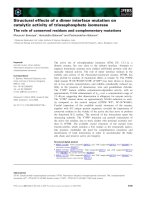
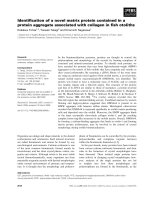
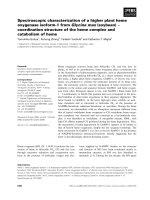
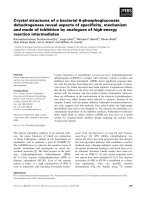

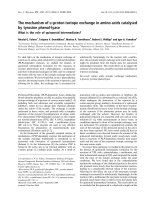

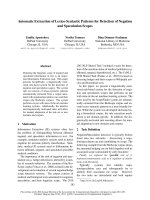
![Tài liệu Báo cáo khoa học: Specific targeting of a DNA-alkylating reagent to mitochondria Synthesis and characterization of [4-((11aS)-7-methoxy-1,2,3,11a-tetrahydro-5H-pyrrolo[2,1-c][1,4]benzodiazepin-5-on-8-oxy)butyl]-triphenylphosphonium iodide doc](https://media.store123doc.com/images/document/14/br/vp/medium_vpv1392870032.jpg)
